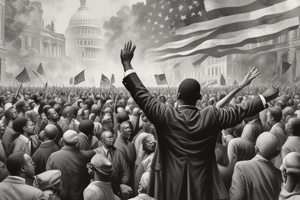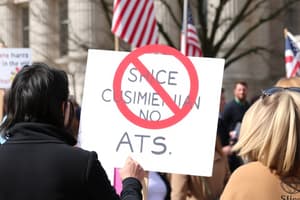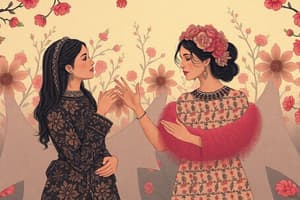Podcast
Questions and Answers
What is the primary requirement for the government to justify unequal treatment under the Equal Protection Clause?
What is the primary requirement for the government to justify unequal treatment under the Equal Protection Clause?
Under which standard does the government have to justify gender-based discrimination?
Under which standard does the government have to justify gender-based discrimination?
Which of the following examples illustrates legal discrimination?
Which of the following examples illustrates legal discrimination?
What does the Eighth Amendment primarily address?
What does the Eighth Amendment primarily address?
What must courts generally do when evaluating claims of unlawful discrimination?
What must courts generally do when evaluating claims of unlawful discrimination?
What are civil rights primarily concerned with?
What are civil rights primarily concerned with?
Which amendment is associated with the due process clause that supports civil rights?
Which amendment is associated with the due process clause that supports civil rights?
What does the equal protection clause of the Fourteenth Amendment guarantee?
What does the equal protection clause of the Fourteenth Amendment guarantee?
Which of the following scenarios is considered unacceptable inequality?
Which of the following scenarios is considered unacceptable inequality?
Until 2015, which group was often denied the right to marry in many U.S. states?
Until 2015, which group was often denied the right to marry in many U.S. states?
What statement reflects Thomas Jefferson's views on slavery?
What statement reflects Thomas Jefferson's views on slavery?
What was one major consequence of the Dred Scott v. Sandford ruling?
What was one major consequence of the Dred Scott v. Sandford ruling?
What did the Emancipation Proclamation achieve?
What did the Emancipation Proclamation achieve?
What was the primary goal of the Thirteenth Amendment?
What was the primary goal of the Thirteenth Amendment?
What characterized the period of Reconstruction after the Civil War?
What characterized the period of Reconstruction after the Civil War?
What standard do courts apply in cases involving discrimination against racial, ethnic, or religious groups?
What standard do courts apply in cases involving discrimination against racial, ethnic, or religious groups?
What is a primary goal of affirmative action programs?
What is a primary goal of affirmative action programs?
Which amendments were proposed to secure political equality and power for formerly enslaved people?
Which amendments were proposed to secure political equality and power for formerly enslaved people?
What issue was rarely recognized as a civil rights concern in the past?
What issue was rarely recognized as a civil rights concern in the past?
What is one method to identify civil rights issues as they emerge?
What is one method to identify civil rights issues as they emerge?
What did the Fourteenth Amendment accomplish regarding citizenship?
What did the Fourteenth Amendment accomplish regarding citizenship?
Which of the following was a consequence of the Fifteenth Amendment?
Which of the following was a consequence of the Fifteenth Amendment?
What was a significant method of disenfranchisement used in the South after Reconstruction?
What was a significant method of disenfranchisement used in the South after Reconstruction?
What was the purpose of the grandfather clause in voting laws?
What was the purpose of the grandfather clause in voting laws?
What was a common characteristic of poll taxes imposed in Southern states?
What was a common characteristic of poll taxes imposed in Southern states?
What major legislation created the Equal Employment Opportunity Commission (EEOC)?
What major legislation created the Equal Employment Opportunity Commission (EEOC)?
Which event is known as 'Bloody Sunday'?
Which event is known as 'Bloody Sunday'?
What did the Voting Rights Act of 1965 aim to eliminate?
What did the Voting Rights Act of 1965 aim to eliminate?
What was Malcolm X's stance on the mainstream civil rights movement?
What was Malcolm X's stance on the mainstream civil rights movement?
What effect did the Supreme Court ruling in Shelby County v. Holder (2013) have on voting laws?
What effect did the Supreme Court ruling in Shelby County v. Holder (2013) have on voting laws?
What was the primary objective of the NAACP when it was founded?
What was the primary objective of the NAACP when it was founded?
What doctrine was upheld by the Supreme Court in Plessy v. Ferguson?
What doctrine was upheld by the Supreme Court in Plessy v. Ferguson?
How did southern states respond to the Supreme Court's ruling in 1938 regarding higher education?
How did southern states respond to the Supreme Court's ruling in 1938 regarding higher education?
What did the Supreme Court rule in Brown v. Board of Education?
What did the Supreme Court rule in Brown v. Board of Education?
What action did Governor Orval Faubus take regarding the integration of Central High School in Little Rock?
What action did Governor Orval Faubus take regarding the integration of Central High School in Little Rock?
What was the primary strategy employed by state leaders in Virginia to resist school integration?
What was the primary strategy employed by state leaders in Virginia to resist school integration?
What ultimately declared the requirement of a poll tax in state elections unconstitutional?
What ultimately declared the requirement of a poll tax in state elections unconstitutional?
Which civil rights organization favored confrontational approaches over legal strategies in the 1950s and 1960s?
Which civil rights organization favored confrontational approaches over legal strategies in the 1950s and 1960s?
What action sparked the Montgomery bus boycott in 1955?
What action sparked the Montgomery bus boycott in 1955?
Which Supreme Court case ruled that restrictive real estate covenants could not be enforced by courts?
Which Supreme Court case ruled that restrictive real estate covenants could not be enforced by courts?
Flashcards
What are Civil Rights?
What are Civil Rights?
Guarantees by the government that it will treat people equally, especially groups historically denied rights or opportunities.
Constitutional Basis of Civil Rights
Constitutional Basis of Civil Rights
The Fifth Amendment's due process clause and the Fourteenth Amendment's equal protection clause ensure equal treatment under the law.
Standards for Judicial Review
Standards for Judicial Review
The courts use specific standards to determine if a discriminatory law or regulation violates the Constitution.
Recognizing a Civil Rights Problem
Recognizing a Civil Rights Problem
Signup and view all the flashcards
Equality in the US Constitution
Equality in the US Constitution
Signup and view all the flashcards
Equal Protection, Good Reason
Equal Protection, Good Reason
Signup and view all the flashcards
Rational Basis Test
Rational Basis Test
Signup and view all the flashcards
Intermediate Scrutiny
Intermediate Scrutiny
Signup and view all the flashcards
Equal Protection Clause
Equal Protection Clause
Signup and view all the flashcards
Civil Liberties vs Civil Rights
Civil Liberties vs Civil Rights
Signup and view all the flashcards
Strict Scrutiny
Strict Scrutiny
Signup and view all the flashcards
Affirmative Action
Affirmative Action
Signup and view all the flashcards
Black Codes
Black Codes
Signup and view all the flashcards
Fourteenth Amendment
Fourteenth Amendment
Signup and view all the flashcards
Fifteenth Amendment
Fifteenth Amendment
Signup and view all the flashcards
What is the contradiction in the Declaration of Independence?
What is the contradiction in the Declaration of Independence?
Signup and view all the flashcards
What is a key argument against the expansion of slavery?
What is a key argument against the expansion of slavery?
Signup and view all the flashcards
What is the Dred Scott v. Sandford decision?
What is the Dred Scott v. Sandford decision?
Signup and view all the flashcards
What is the Emancipation Proclamation known for?
What is the Emancipation Proclamation known for?
Signup and view all the flashcards
What was the Reconstruction Era?
What was the Reconstruction Era?
Signup and view all the flashcards
Disenfranchisement
Disenfranchisement
Signup and view all the flashcards
Literacy Test
Literacy Test
Signup and view all the flashcards
Grandfather Clause
Grandfather Clause
Signup and view all the flashcards
Poll Tax
Poll Tax
Signup and view all the flashcards
White Primary
White Primary
Signup and view all the flashcards
Disenfranchisement by Primary Elections
Disenfranchisement by Primary Elections
Signup and view all the flashcards
Separate But Equal Doctrine
Separate But Equal Doctrine
Signup and view all the flashcards
Jim Crow Laws
Jim Crow Laws
Signup and view all the flashcards
NAACP and Legal Strategies
NAACP and Legal Strategies
Signup and view all the flashcards
Overturning 'Separate But Equal'
Overturning 'Separate But Equal'
Signup and view all the flashcards
De Facto School Segregation in the South
De Facto School Segregation in the South
Signup and view all the flashcards
Massive Resistance to School Integration
Massive Resistance to School Integration
Signup and view all the flashcards
De Facto Segregation in the North
De Facto Segregation in the North
Signup and view all the flashcards
Court Ruling: De Facto Segregation in New York
Court Ruling: De Facto Segregation in New York
Signup and view all the flashcards
Redlining and Its Impacts
Redlining and Its Impacts
Signup and view all the flashcards
What did the Civil Rights Act of 1964 outlaw?
What did the Civil Rights Act of 1964 outlaw?
Signup and view all the flashcards
How did the Civil Rights Act of 1964 affect employment?
How did the Civil Rights Act of 1964 affect employment?
Signup and view all the flashcards
What was the impact of the Voting Rights Act of 1965?
What was the impact of the Voting Rights Act of 1965?
Signup and view all the flashcards
What challenge did the Voting Rights Act face?
What challenge did the Voting Rights Act face?
Signup and view all the flashcards
How did Malcolm X and the Black Panthers differ from the mainstream civil rights movement?
How did Malcolm X and the Black Panthers differ from the mainstream civil rights movement?
Signup and view all the flashcards




